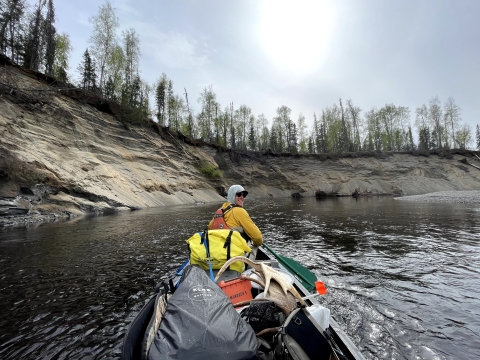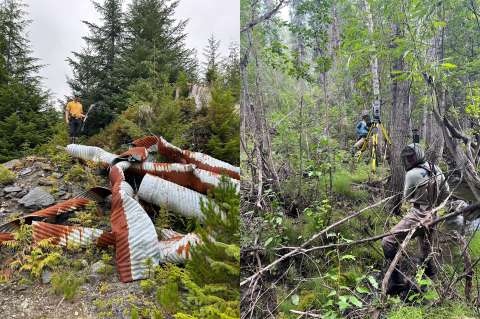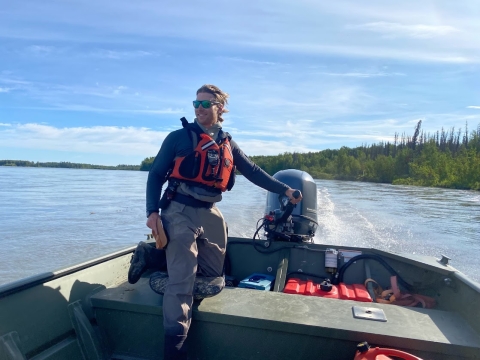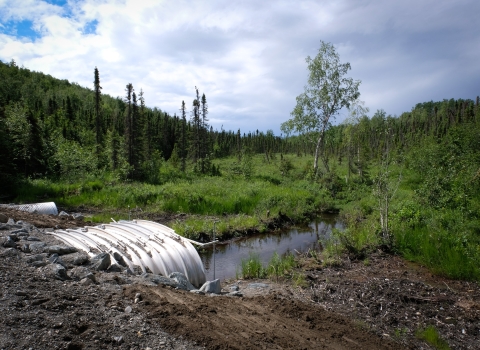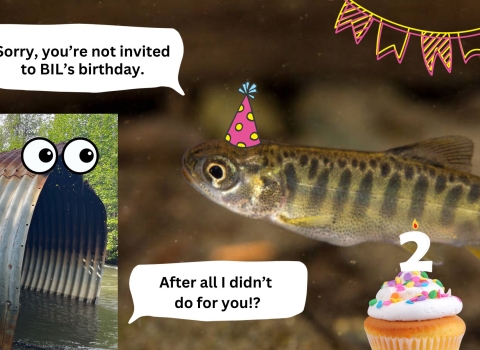The Gulkana River, whose three forks comprise the largest clearwater system in the Copper River Basin, is many things for many communities – a home for rainbow trout, arctic grayling, and Chinook salmon; a nesting place for trumpeter swans and bald eagles who settle along its shores; and a provider of subsistence lifeways, clean water, and food for the Ahtna people.
And, for a nine day stretch in 2022, these roaring waters assumed yet another identity: Tim Ericson’s “office.” A fish and wildlife biologist in the Southern Alaska Fish and Wildlife Conservation Office (SAFWCO), Ericson, along with his trip partner, Grace Kirkey, had come to the Gulkana to install arrays of temperature loggers that would collect and report river temperatures every 15 minutes.
Covering around 100 river miles, beginning in the head waters of the river’s West Fork and washing out in Sourdough, the duo successfully installed the technology in eight locations – each site consisting of a logger placed upstream on the river, in a tributary, and downstream on the river’s main stem. Though it wasn’t always smooth sailing. Navigating myriad log jams in the midst of heavy storms, the air thick with rain and mosquitos alike, made for some speed bumps along the way.
“We had one really long day, like 14 hours, and then other days where you get really wet, fall into the river and swamp your waders,” says Ericson, who joined the Service in Alaska in May 2021. “‘When we get to the next gravel bar, we’re calling it. Let's build a fire, dry off, and get warm.’ But we came out of it as good friends. That was definitely a highlight of my time with our Fisheries Branch.”
Rafting, canoe surveying, and wading through rivers to complete juvenile salmon assessments scratch only the surface of Ericson’s field work experiences – which, he says, if made into a movie, would most aptly be titled “Workin’ in the Rain.”
“Sometimes it’s not even worth looking at the weather report, because you know it’s gonna be rough,” he says. “Pack like three rain jackets and hope that can see you through.”
In November 2022, Ericson transitioned from SAFWCO’s Fisheries branch into the office’s Habitat Restoration program, where fish passage in southeast Alaska – a program led by Andy Stevens – has been his primary focus. Here, where Tribal groups, non-governmental organizations, and state and federal agencies have all contributed to cataloguing streams and road-stream crossings, the branch’s biologists often encounter habitats with infrastructural scars from the area’s historic logging years.
“The forest has taken back over, and legacy roads, with all these ghost pipes of forgotten or undocumented culverts, are left,” he says. “The highlight for a lot of folks, and myself included, is doing all the offseason work to know what the upcoming field season is going to be like."
Year-round, but especially in the winter months, Ericson and others use satellite imagery to identify where streams in the region might flow, marking other geographical features, such as valleys, to assess how steep, narrow, or fast flowing a channel may be. They also, to the extent the imagery allows, try to identify any visual barriers to fish passage fish passage
Fish passage is the ability of fish or other aquatic species to move freely throughout their life to find food, reproduce, and complete their natural migration cycles. Millions of barriers to fish passage across the country are fragmenting habitat and leading to species declines. The U.S. Fish and Wildlife Service's National Fish Passage Program is working to reconnect watersheds to benefit both wildlife and people.
Learn more about fish passage . Ultimately, they ask themselves: Can a fish still swim here, uninhibited?
If there are doubts, the next step, Ericson says, “is getting boots on the ground” – a process that is easier said than done. Most trips through southeast Alaska’s unique geography require at least two planes and a boat ride to get to a desired location (During his very first trip to the region, preparing to return to Anchorage after a week on Prince of Wales Island, Ericson arrived at the airport as a nearby volcano erupted, spewing ash, causing the cancellation of five flights and inducing a scrambly few days of travel).
Once at a site – arriving by plane, train, or catamaran – and equipped with field maps, a stadia rod, and digital surveying technology, biologists look for culverts or pipes that are perched, undersized, rusting, or misaligned with the stream, which spur erosion and scouring issues.
“Essentially, you're out there asking, ‘If I was a fish, could I swim through this pipe with unimpeded access?’” Ericson says. “The goal is to create a non-fragmented stream that fish can cross through, without even knowing they are going under a road.”
Assessing the land, restoring streams, and removing pipes means working with and centering the knowledge of local partners, especially Alaska Native communities. Ericson and the team work primarily on Native Corporation lands, and in the Tongass National Forest. Strengthened by Tribal Forest Partnerships – including the Klawock Indigenous Stewards Forest Partnership, Hoonah Native Forest Partnership, and Keex' Kwaan Community Forest Project – Tribes’ natural resource departments allow the team access to lands and data collection initiatives. The Southeast Alaska Watershed Coalition is the team’s primary partner in the region.
“There are folks who have lived off the land for millennia, and they want to make sure they protect it,” Ericson says. “You meet some great people who are really passionate about where they're from, and for me, representing the U.S. Fish and Wildlife Service, it's great to hear their perspectives and just listen.”
Having grown up and worked in northern Wisconsin and other parts of the upper Midwest, Ericson also appreciates the differences between Alaska and the Lower 48. During past experiences in Minnesota, for example, surveys and field work often ran up against industrial barriers or pollution-heavy harbors.
With such large amounts of intact and healthy habitat in Alaska, conservation work feels, and is, especially important and rewarding.
“Having an intact reference reach, to base a fish passage design off of, is possible up here unlike many places in the lower 48,” Ericson says. “It’s easy, when thinking of Pacific Salmon, to see how they fit into the economy, culture, and lifestyle here. The impact of this work seems hard to compare to the Upper Midwest where I was coming from.”
But the people he works with, Ericson emphasizes, are why coming to the office – be it the actual Field Office, or the lapping surface of a wild and scenic river – is so special.
“We have such a great team here, and I'm super excited for the work that we do, have done, and will do in the future,” he says.

